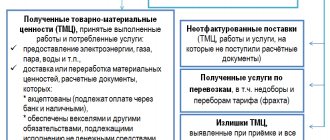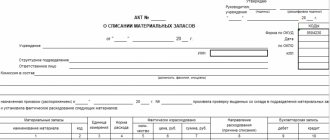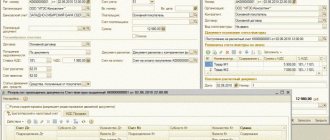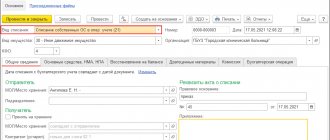Types of accounting standards
Federal Law “On Accounting” No. 402-FZ dated December 6, 2011, part 1 of Art. 21 identifies the following types of accounting standards:
- federal - established by the legislation of the country, relevant for any organizations operating on the territory of the Russian Federation;
- industry - adopted by regulatory documents for the relevant field of activity;
- internal - adopted by local acts of each individual enterprise.
IMPORTANT! Federal and industry standards are mandatory. When developing internal standards, the organization must ensure that they do not contradict industry and federal ones.
What documents previously set the rules?
FSBU 27/2021 replaced two documents:
- “Regulations on documents and document flow in accounting”, approved by Order of the USSR Ministry of Finance No. 105 about 40 years ago - July 29, 1983,
- “Regulations on accounting and financial reporting in the Russian Federation” was approved by Order of the Ministry of Finance of Russia No. 34n more than 20 years ago - July 29, 1998.
The predecessor documents of the new Federal Standard were more comprehensive, for example, the Accounting Regulations include 6 chapters and 101 paragraphs. From the beginning of 2022, these documents will no longer be valid.
The new standard for the preparation and movement of documents within the company will come into force on January 1, 2022. The FSBU is not a revolutionary document; it complements and clarifies the existing legislative framework on the issue of accounting, namely the Federal Law “On Accounting”.
Features of industry standards
Industry standards are rules governing the application of federal accounting standards in different sectors of operation, created taking into account the nuances of individual types of activities (industries) or their areas.
What industry accounting standard is used for securities transactions in non-credit financial institutions ?
The principles for drawing up industry, as well as other accounting standards, are aimed at regulating them:
- bringing requirements into line with the needs of people and organizations preparing and receiving financial statements;
- achieving the current level of development of practice and scientific methods of financial accounting;
- organization of unity of rules for various accounting systems;
- simplification of accounting and reporting (for those categories entitled to apply simplified accounting methods).
FOR YOUR INFORMATION! It is strictly forbidden for the powers to adopt industry standards and control in the field of financial accounting to overlap.
Common features between federal and industry standards
- Regulate accounting methods in the organization.
- Unconditionally required for use.
- Install:
- minimum required accounting rules;
- acceptable accounting methods.
What to do if federal and industry accounting standards on a certain accounting issue are not approved ?
Differences between industry standards and federal standards
- Industry standards specify federal ones.
- They have a more basic mechanism of use.
- The type of activity for which they are created is taken into account.
- Can be approved only based on the results of an examination by the Standards Council.
Industry standards can be universal for certain areas of activity, detail special rules for accounting, or reveal the peculiarities of its conduct in specific areas.
NOTE! In light of the gradual transition to international accounting standards (IFRS), the development and use of industry standards is highly appropriate. The Central Bank of the Russian Federation, which regulates the domestic market, is actively developing and implementing standards for all major industries operating today in various economic sectors.
Russian accounting standards: federal, industry, intra-company
Economics and accounting by industry are studied at universities in the Russian Federation and are one of the most popular specialties among applicants.
Industry accounting standards are included by the Law “On Accounting” dated December 6, 2011 No. 402-FZ in the general group of normative legal acts regulating accounting issues, along with:
- federal accounting standards;
- recommendations in the field of accounting;
- company standards.
The industry accounting standard (based on the general definition of the standard) establishes 2 types of requirements:
- minimum necessary - in relation to accounting requirements;
- acceptable - relating to the accounting methods used.
Distinctive features of industry accounting standards:
- mandatory - they must be applied by all organizations, unless otherwise provided in their text;
- specificity - they regulate the nuances of the application of federal standards, taking into account the specifics of individual types of activities;
- controllability - they are allowed for use after passing a special examination conducted by the Accounting Standards Council.
Industry accounting standards have both similarities and differences with federal accounting standards, which have the following characteristics:
- universality - they are subject to application regardless of the type of activity (unless otherwise indicated in their text);
- selective detailing - they can clarify individual accounting requirements (in budget accounting, for certain types of activities);
- controllability - undergo examination by the Accounting Standards Council.
Each organization has the right to develop its own internal accounting standards:
- based on the norms of current accounting legislation;
- complementary to existing federal and industry standards;
- being part of the internal company accounting policy.
The following materials will tell you how to develop an accounting policy that regulates the forms and methods of tax accounting:
- “Accounting policy under the Unified Agricultural Tax - features of formation”;
- “Rules for drawing up accounting policies for UTII”.
Industry and intra-company accounting standards also have similarities and differences. Main characteristics of intra-company standards (IFS):
- VFS are voluntary in nature - the need for their development, modification and cancellation is established by the companies themselves;
- VFS are created by an economic entity in order to streamline its accounting;
- VFS are used to the same extent by all divisions of the subject.
Study a variety of standards using materials posted on our website:
- "List of IFRS standards";
- “In-house audit standards (nuances)”.
Reasons for developing industry standards
In addition to the need to bring accounting requirements closer to international ones, the Bank of the Russian Federation is guided by the following considerations that dictate the emergence of various industry standards:
- the desire for universality of accounting reporting;
- the desire to increase the information content of the submitted forms;
- the planned transition in the near future to a chart of accounts that is unified for credit and non-credit financial institutions.
Industry standards are constantly updated and introduced into the life of organizations gradually, as they are adopted and approved by the Standards Council.
Who develops accounting recommendations?
Recommendations are developed and adopted by non-state regulators: the Accounting Methodological Center (AMC) and the Institute of Professional Accountants and Auditors of Russia (IPBR). The first developed 123 recommendations, the second - 2. Since I cooperate with the BMC, I will talk about the adoption of recommendations using his example.
Most members of the BMC are current chief accountants and heads of accounting departments of a large Russian corporation. The initiative to develop a new recommendation usually comes from those of them who are faced with “blind spots” in accounting for some facts of economic life. The problem is being discussed at the BMC. If the majority comes to the conclusion that a recommendation is needed on the issue under discussion, a draft is prepared.
When developing a project, FSBU and OSBU standards are taken into account - the recommendation should not contradict them. The relevant International Financial Reporting Standards and the practice of their application are also analyzed. The project is discussed at meetings of relevant committees, finalized and adopted by open voting.
Examples of industry standards
When releasing a new industry standard, the Bank of the Russian Federation places it on its official website. In addition to those already approved, it contains draft standards that are being prepared for examination. Regarding each of the published Regulations, the Bank of Russia publishes special explanations and instructions. Let us give examples of the latest new industry standards from the Bank of the Russian Federation.
- Industry standards for non-credit financial institutions (NFIs):
- for activities under a property trust management agreement (No. 505-p dated November 18, 2015);
- for transactions with reserves reflecting estimated and contingent liabilities of non-credit organizations (No. 508-p dated December 3, 2015);
- accounting of derivative financial instruments (No. 488-p dated September 4, 2015);
- accounting of income, expenses, other comprehensive income (No. 487 dated September 04, 2015);
- the procedure for drawing up accounting reporting documents (No. 526-p dated December 28, 2015);
- the procedure for preparing financial statements of securities market participants and various investment funds, trade organizers and counterparties, credit rating and credit history agencies, insurance brokers (No. 532-P dated February 3, 2016), etc.
- Industry standards for insurance organizations:
- the procedure for drawing up documents for accounting reports (No. 526-p dated December 28, 2015);
- operations for conducting insurance activities (No. 502-p dated November 5, 2015);
- accounting in Russian insurance organizations and mutual insurance companies (No. 491-P September 04, 2015), etc.
- Industry standards for credit financial institutions (CFO):
- rules for calculating and paying remuneration to KFO staff (No. 465-p dated April 15, 2015);
- features of meeting reserve requirements (No. 554-p dated October 20, 2016);
- accounting for fixed assets, real estate, assets that are temporarily not in use, inventories intended for sale and received as collateral or compensation (No. 448-p dated December 22, 2014);
- requirements for hedging (No. 525-p dated December 28, 2015), etc.
Innovations for 2022
The Bank of Russia began to perform new, additional functions: to regulate industry requirements for accounting of certain types of activities. For example, previously control for non-credit financial organizations was carried out by the Financial Service for Financial Markets and the Federal Insurance Supervision Service, and the requirements themselves were developed by the Ministry of Finance of the Russian Federation. For NFOs, from January 1, 2022, industry standards adopted by the Bank of Russia come into force: these organizations must switch to the new PBU.
To create Regulations regarding accounting in NFOs, the Bank of Russia used the framework it had previously developed regarding CFOs. Many points remain the same, but there are also innovations associated with the widespread convergence with IFRS.
REFERENCE! If in the provisions adopted by the Bank of the Russian Federation as the main market regulator, any issues are not resolved in the relevant regulations, it is recommended to use the requirements of IFRS.
Specialized organizations are ready to help enterprise management quickly switch to new methods of accounting by providing assistance in:
- formulation of accounting policies;
- correlation of existing PBUs with industry and federal standards;
- numbering of new personal accounts;
- developing a methodology for assessing assets and liabilities;
- automation of accounting according to new requirements.
Specialists are ready to train and advise accounting workers on any issues related to the transition to a new level of accounting for financial activities.
What is FBSU 27/2021?
The new Federal Accounting Standard FBSU 27/2021 was approved by order of the Ministry of Finance on May 16, 2022 under number 62n. The document consists of 8 pages, two of which are the text of the order on the introduction of the standard and 6 pages are the text of the FBSU itself.
To switch to electronic document management, you must enter into an agreement with an EDF operator and obtain an electronic signature on a certified medium.
We will select the optimal EDI tariff
The Federal Accounting Standard consists of 5 chapters and 30 paragraphs, which briefly and succinctly outline modern requirements for accounting documents.
5 sections of FSBU 27/2021:
- General provisions.
- Requirements for accounting documents.
- Correction of accounting documents.
- Storage of accounting documents.
- Document flow in accounting.







